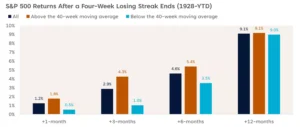Building on modest gains last week that ended the S&P 500’s four-week losing run, stocks were gaining on Monday.

The benchmark index was up 4% after it entered its first decline since 2023 earlier this month, with the S&P 500 up more than 1.5% in recent trading. Last week, the S&P 500 had its first weekly increase since mid-February, rising 0.5 percent.
Adam Turnquist, Chief Technical Strategist at LPL Financial, stated in a note on Monday that four-week losing streaks are not common. Turnquist says they have only happened 66 times since 1928. Additionally, historically, they usually come before prosperous periods. After monthlong losing streaks, stocks have posted an average one-month gain of 1.2% and an average three-month gain of 2.9%. Six-month gains have averaged 4.6%

These rallies are mediocre at best, not remarkable. The average yearly return of the S&P 500 is just over 10%.
Turnquist’s findings do have one minor qualification, though: if the S&P 500 drops below its 200-day moving average, as it did during the most recent sell-off, the recovery from a four-week slump is typically much smaller. Losing streaks have been followed by average one-, three-, and six-month returns of 0.5%, 1%, and 3.5%, respectively, in situations similar to the one we are in right now.
In the long term, though, the 200-day moving average has less of an impact. Regardless of whether it is over or below that threshold, the S&P 500 typically recovers by 9% in the year after a poor four-week period.



